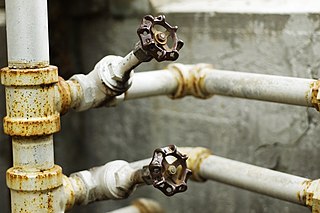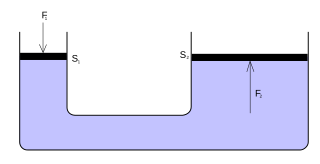
A valve is a device or natural object that regulates, directs or controls the flow of a fluid by opening, closing, or partially obstructing various passageways. Valves are technically fittings, but are usually discussed as a separate category. In an open valve, fluid flows in a direction from higher pressure to lower pressure. The word is derived from the Latin valva, the moving part of a door, in turn from volvere, to turn, roll.

Hydraulic shock is a pressure surge or wave caused when a fluid in motion is forced to stop or change direction suddenly: a momentum change. It is usually observed in a liquid but gases can also be affected. This phenomenon commonly occurs when a valve closes suddenly at an end of a pipeline system and a pressure wave propagates in the pipe.

Fluid power is the use of fluids under pressure to generate, control, and transmit power. Fluid power is conventionally subdivided into hydraulics and pneumatics. Although steam is also a fluid, steam power is usually classified separately from fluid power. Compressed-air and water-pressure systems were once used to transmit power from a central source to industrial users over extended geographic areas; fluid power systems today are usually within a single building or mobile machine.

In automotive engineering, an exhaust manifold collects the exhaust gases from multiple cylinders into one pipe. The word manifold comes from the Old English word manigfeald and refers to the folding together of multiple inputs and outputs.

Hydraulic machines use liquid fluid power to perform work. Heavy construction vehicles are a common example. In this type of machine, hydraulic fluid is pumped to various hydraulic motors and hydraulic cylinders throughout the machine and becomes pressurized according to the resistance present. The fluid is controlled directly or automatically by control valves and distributed through hoses, tubes, or pipes.

Electronic-hydraulic analogies are the representation of electronic circuits by hydraulic circuits. Since electric current is invisible and the processes in play in electronics are often difficult to demonstrate, the various electronic components are represented by hydraulic equivalents. Electricity was originally understood to be a kind of fluid, and the names of certain electric quantities are derived from hydraulic equivalents.

In petroleum and natural gas extraction, a Christmas tree, or tree, is an assembly of valves, casing spools, and fittings used to regulate the flow of pipes in an oil well, gas well, water injection well, water disposal well, gas injection well, condensate well, and other types of well.

A solenoid valve is an electromechanically operated valve.

A hydraulic brake is an arrangement of braking mechanism which uses brake fluid, typically containing glycol ethers or diethylene glycol, to transfer pressure from the controlling mechanism to the braking mechanism.

A hydraulic cylinder is a mechanical actuator that is used to give a unidirectional force through a unidirectional stroke. It has many applications, notably in construction equipment, manufacturing machinery, elevators, and civil engineering. A hydraulic cylinder is a hydraulic actuator that provides linear motion when hydraulic energy is converted into mechanical movement. It can be likened to a muscle in that, when the hydraulic system of a machine is activated, the cylinder is responsible for providing the motion.
Back pressure is the term for a resistance to the desired flow of fluid through pipes. Obstructions or tight bends create backpressure via friction loss and pressure drop.
A Block and bleed manifold is a hydraulic manifold that combines one or more block/isolate valves, usually ball valves, and one or more bleed/vent valves, usually ball or needle valves, into one component for interface with other components of a hydraulic (fluid) system. The purpose of the block and bleed manifold is to isolate or block the flow of fluid in the system so the fluid from upstream of the manifold does not reach other components of the system that are downstream. Then they bleed off or vent the remaining fluid from the system on the downstream side of the manifold. For example, a block and bleed manifold would be used to stop the flow of fluids to some component, then vent the fluid from that component’s side of the manifold, in order to effect some kind of work (maintenance/repair/replacement) on that component.

A scuba manifold is a device incorporating one or more valves and one or more gas outlets with scuba regulator connections, used to connect two or more diving cylinders containing breathing gas, providing a greater amount of gas for longer dive times or deeper dives. An isolation manifold allows the connection between the cylinders to be closed in the case of a leak from one of the cylinders or its valve or regulator, conserving the gas in the other cylinder. Diving with two or more cylinders is often associated with technical diving. Almost all manifold assemblies include one cylinder valve for each cylinder, and the overwhelming majority are for two cylinders.
The following outline is provided as an overview of and topical guide to automobiles:

A manifold is a wider and/or larger pipe or channel, into which smaller pipes or channels lead, or a pipe fitting or similar device that connects multiple inputs or outputs for fluids.

A booster pump is a machine which increases the pressure of a fluid. It may be used with liquids or gases, and the construction details vary depending on the fluid. A gas booster is similar to a gas compressor, but generally a simpler mechanism which often has only a single stage of compression, and is used to increase pressure of a gas already above ambient pressure. Two-stage boosters are also made. Boosters may be used for increasing gas pressure, transferring high pressure gas, charging gas cylinders and scavenging.
Hydraulics is a topic in engineering dealing with the mechanical properties of liquids.
An isolation valve is a valve in a fluid handling system that stops the flow of process media to a given location, usually for maintenance or safety purposes. They can also be used to provide flow logic, and to connect external equipment to a system. A valve is classified as an isolation valve because of its intended function in a system, not because of the type of the valve itself. Therefore, many different types of valves can be classified as isolation valves.
Alvheim Field is a Norwegian oil and gas field located in the northern part of the North Sea near the border with the British sector, consisting mainly of Boafält, Kneler Field and Kameleon Field. Parts of the Boafält are located in the British sector at block 9/15. The reservoir consists of early-tier sandstone. The depth of the area is 120–130 meters. The production ship is located approximately 12 km west of Heimdal Gassenter, at 59.56684°N 1.99731°E.
A hot stab is a type of subsea connector specifically designed to be easily inserted and removed by a remotely operated underwater vehicle (ROV) manipulator arm. The hot stab is the connector which supplies remote utilities. It is normally inserted into a port after removing the plug stab, which is left in the port when the hot stab is disconnected, to keep the port clean and free of fouling when not in use. The alignment is generally not critical for insertion, and the stab is guided into the port by the port geometry, which tends to be concentric cylinder and cone sections, tapering down from the handle end to the tip, with a series of O-ring seals separating the ports or contacts spaced along the length. The stab may be locked into place or may require the ROV to hold it in place while it is in use.












